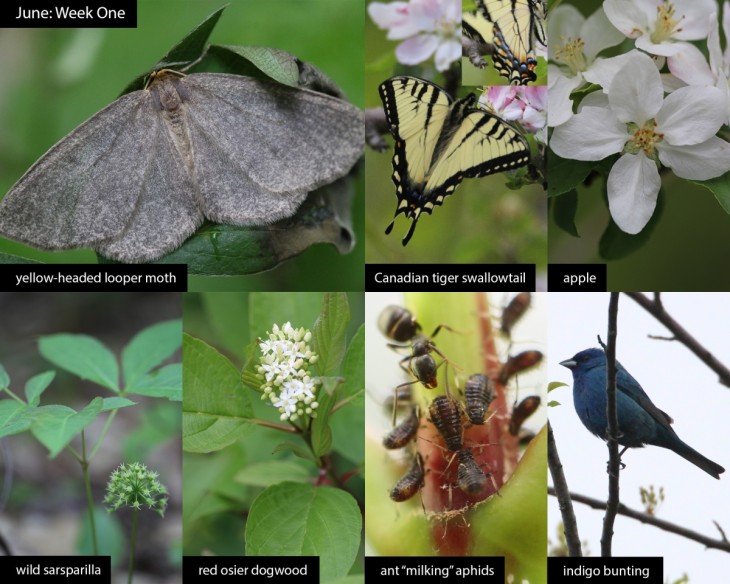This week in the woods, we found this yellow-headed looper moth hiding its titular head beneath a fold in a leaf. This moth also goes by the common names pitch pine looper and eastern pine looper, owing to its larvae’s dependence on pine needles for food (although they also dine on oak). Nocturnal moths sleeping during the day give us the opportunity to observe their flat, spread-out wings carefully. Moths and butterflies share the order Lepidoptera (a name from the Greek for “scaled wing”) and have tiny modified hairs known as scales arranged in overlapping patterns on their wings, like roof shingles or fish scales. If you’ve ever touched butterfly or moth wings, the scales are what come off as fine dust in your fingers. While blacks and browns come from melanins in Lepidoptera wings, other colors more often come from the scales’ microstructure rather than pigments.
More Lepidoptera you might see in numbers this week: Canadian tiger swallowtails, seeming to be all wings as they flutter and flop across woodland opening, yard, and road. Biologists separated the Canadian tiger swallowtail from the eastern tiger swallowtail only in 1991; these “sibling species” have have highly similar outward appearances, and their ranges overlap in the Upper Valley. We can determine that this tiger swallowtail is a Canadian from the markings on the undersides of its wing, with the black line nearest the body being very wide (see inset). Bryan Pfeiffer explains more about how to distinguish between tiger swallowtail species on his Substack.
If you have the luck of this butterfly, you still might find the last apple blossoms at higher altitudes. Apples have “perfect” flowers, with male and female parts on the same tree and rely on insects or hummingbirds to transport pollen from male to female flowers. Freedom from frost during bloom and high bee activity should mean fruit in the fall.
Wild sarsaparilla also approaches the end of its blooming season. Among a patch of plants that had already lost their petals, we found this single flower—a spherical cluster on a separate stem from the shrub’s compound leaves.
Red osier dogwood, perhaps the most widespread dogwood species in North America, puts out flat-topped clusters of small white flowers and blooms into this month. This tree’s strong stems and interwoven tangle of stolons connect to one another underground in a mat and stabilize the banks of rivers and streams.
On this red maple sapling, we found ants “milking” aphids, which were drinking the tree’s sweet sap on its way to the terminal bud. Aphids cannot digest all the sugar they ingest and excrete some from their anuses in the form of honeydew. This photo taken by Ann Little shows an ant (perhaps an odorous house ant) stroking the aphids’ backs with antennae to stimulate release of the honeydew. In mutualistic exchange for the steady supply of food, the ants provide security from predators and sometimes even take aphids underground in the fall to protect them from the cold.
This male indigo bunting showed a deep dark blue in the low light conditions we have been getting during these weeks of rainy weather. Similar to butterfly and moth scales in how they achieve color, the feathers do not contain blue pigments; as Will Durkin explains in last week’s Outside Story article, the blue comes from diffraction, a process in which the feather’s microscopic structure scatters sunlight and reflects all colors except blue. It also means that the color can vary greatly depending on the quality of light.
What have you noticed in the woods this week? Submit a recent photo for possible inclusion in our monthly online Reader Photo Gallery.



Discussion *